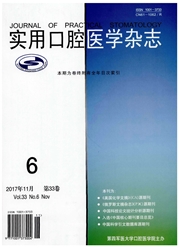

 中文摘要:
中文摘要:
目的:观察静压力对钛纳米管表面的骨髓间充质干细胞(BMSCs)生物学特点的影响。方法:将大鼠BMSCs分别接种于纯钛抛光(PT组)和TiO2纳米管(NT组)试件表面;常规培养24 h后,将每组试件各随机分为0 kPa组和90 kPa组(分别记为0 PT、0 NT、90 PT、90 NT),一并置于细胞液压加载装置中进行培养,并分别给予1 h/d的0 kPa和90 kPa静压力刺激。于培养1、4、7 d用CCK-8检测各组细胞的增殖能力;培养3 d时通过免疫荧光染色和场发射扫描电镜(FE-SEM)分别观察细胞的骨架及形态;培养7 d时用ALP试剂盒检测各组细胞的ALP活性。结果:纯钛抛光试件经阳极氧化处理后,在其表面制备出一层由垂直管状结构构成的阵列;培养4 d时加载90 kPa液体静压力能明显促进BMSCs在PT、NT试件表面的增殖、伪足的铺展及F-actin、ALP的表达(P<0.05);纳米形貌和力学刺激共同作用7 d时,BMSCs的增殖能力明显低于对照组(P<0.05),但其伪足的伸展、F-actin、ALP的表达量均较对照组明显升高(P<0.05)。结论:纳米形貌和液体静压力可协同影响BMSCs的增殖、细胞形态、细胞骨架及ALP表达。
 英文摘要:
英文摘要:
AIM:To investigate the effects of hydrostatic pressure on the biological behavior of bone marrow mesenchymal stem cells (BMSCs)cultured on titanium surfaces.METHODS:Pure titanium samples were divided in-to polished Ti (PT)and TiO2 nanotube array (NT)groups according to the surface modality.BMSCs were obtained from SD rats and inoculated on the titanium samples.Then the BMSCs were treated by hydrostatic pressure at 0 or 90 kPa for 1 h/d.CCK-8 method was used to determine cell proliferation at 1 ,4 and 7 d respectively after pressure treat-ment.Fluorescence staining and field-emission scanning electron microscopy (FE-SEM)were used to observe the cell skeleton and morphology after the cells were cultured for 3 d,intracellular alkaline phosphatase (ALP)activity was measured by ALP kit after the cells were cultured for 7 d.RESULTS:Anodization of pure titanium samples formed TiO2 nanotube array on the surface.Hydrostatic pressure of 90 kPa promoted the proliferation and ALP activity of BM-SCs on PT surface after the cells were cultured for 4 d (P〈0.05).The actin filaments became denser and thicker.The shape of cells on all surface was more elongated and pseudopodium was also become larger after loading hydrostatic pres-sure.Hydrostatic pressure on NT surface decreased the proliferation of BMSCs after 7 d culture ,but increased F-actin and ALP expression (P〈0.05 ).CONCLUSION:Mechanical pressure and substrate nanotopography may synergisti-cally affect the proliferation,cytoskeleton,morphology and intracellular ALP activity of BMSCs.
 同期刊论文项目
同期刊论文项目
 同项目期刊论文
同项目期刊论文
 Induction of osteogenic differentiation of stem cells via a lyophilized microRNA reverse transfectio
Induction of osteogenic differentiation of stem cells via a lyophilized microRNA reverse transfectio Effects of micropitted/nanotubular titania topographies on bone mesenchymal stem cell osteogenic dif
Effects of micropitted/nanotubular titania topographies on bone mesenchymal stem cell osteogenic dif Immobilization of Ag nanoparticles/FGF-2 on a modified titanium implant surface and improved human g
Immobilization of Ag nanoparticles/FGF-2 on a modified titanium implant surface and improved human g The role of integrin-linked kinase/beta-catenin pathway in the enhanced MG63 differentiation by micr
The role of integrin-linked kinase/beta-catenin pathway in the enhanced MG63 differentiation by micr Bone integration capability of a series of strontium-containing hydroxyapatite coatings formed by mi
Bone integration capability of a series of strontium-containing hydroxyapatite coatings formed by mi MicroRNA Functionalized Microporous Titanium Oxide Surface by Lyophilization with Enhanced Osteogeni
MicroRNA Functionalized Microporous Titanium Oxide Surface by Lyophilization with Enhanced Osteogeni The role of the Wnt/beta-catenin pathway in the effect of implant topography on MG63 differentiation
The role of the Wnt/beta-catenin pathway in the effect of implant topography on MG63 differentiation Concentration- and time-dependent response of human gingival fibroblasts to fibroblast growth factor
Concentration- and time-dependent response of human gingival fibroblasts to fibroblast growth factor Osteogenic activity and antibacterial effects on titanium surfaces modified with Zn-incorporated nan
Osteogenic activity and antibacterial effects on titanium surfaces modified with Zn-incorporated nan Involvement of N-cadherin/beta-catenin interaction in the micro/nanotopography induced indirect mech
Involvement of N-cadherin/beta-catenin interaction in the micro/nanotopography induced indirect mech 期刊信息
期刊信息
